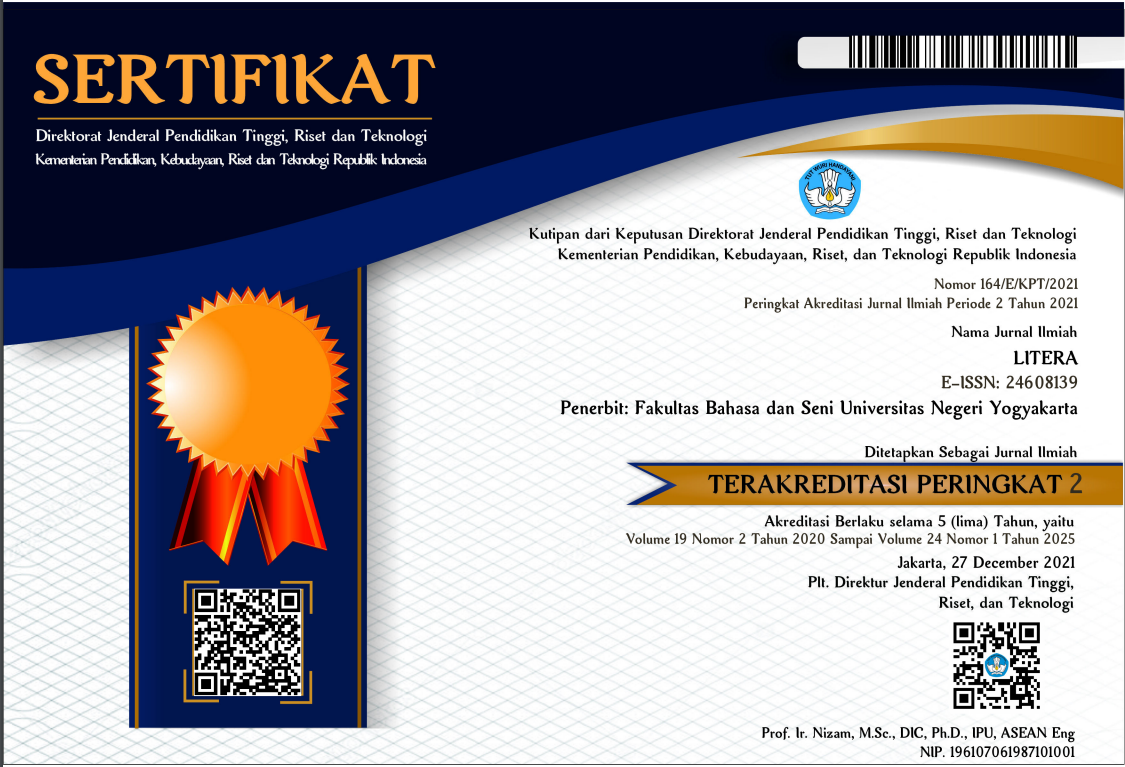MAKNA REALISME MAGIS DALAM NOVEL JOURS DE COLÈRE DAN ’ENFANT MÉDUSE KARYA SYLVIE GERMAIN
Mega Subekti, Universitas Padjadjaran, Indonesia
Vincentia Tri Handayani, universitas padjadjaran, Indonesia
Abstract
Abstrak
Dalam sastra, realisme magis dianggap sebagai alat yang ampuh untuk menunjukkan perlawanan terhadap kolonialisme dan neokolonialisme, terutama di negara berkembang yang sebagian besar masyarakatnya digambarkan masih menderita akibat efek destruktif kolonialisme. Penelitian bertujuan mendeskripsikan makna realisme magis dalam novel Jours de Colère dan l’Enfant Méduse karya Sylvie Germain. Berbeda dengan definisi genre fantastique (Todorov, 1970), realisme magis hadir sebagai bagian wajar dan tak terpisahkan dari cerita yang realis (Chanady, 1985). Realisme magis yang ada dalam kedua novel ini ada pada mitos, legenda, dan dongeng yang tergambar dalam narasi, deskripsi, maupun tokoh-tokohnya. Sejalan dengan Eugene Arva (1995) yang mengungkapkan bahwa realisme magis adalah jalan untuk mengungkapkan trauma yang tidak bisa diungkapkan, tokoh-tokoh dalam kedua novel memiliki pengalaman traumatis baik yang disaksikan maupun yang dialami sendiri. Dengan menggunakan pendekatan kualitatif dan metode deskriptif analitis, hasil penelitian ini menunjukkan bahwa hal-hal magis yang melekat pada tokoh-tokoh di kedua novel dapat diargumentasikan bermakna sebagai strategi untuk mengungkapkan berbagai kejadian ekstrem yang ada dalam novel seperti kekerasan seksual dan pembunuhan. Penggunaan realisme magis ini tidak berfungsi untuk membuat pembaca memahami, namun untuk merasakan peristiwa yang terjadi.
Kata Kunci: realisme magis, le mal, fantasi, trauma
Abstract
This paper is intended to reveal the meaning of magical realism in the novels of Sylvie Germain's Jours de Colère l’Enfant Méduse. In contrast to the definition of the genre fantastique (Todorov, 1970), magical realism is present as a reasonable and inseparable part of a realist story (Chanady, 1985). The magical realism that exists in these two novels lies in myths, legends, and fairy tale that are depicted in the narration, description, and characters. Eugene Arva (1995) revealed that magical realism is a way to express unexplained trauma, the characters in both novels have traumatic experiences both witnessed and experienced by themselves. By using a qualitative approach and analytical descriptive method, the results of this study indicate that the magical things inherent in the characters in both novels can be argued as a strategy to express extreme events experienced such as sexual violence and murder. The use of magic realism is not working to make the reader understand, but to feel the events that occurred.
Keywords: Magical realism, evil, fantasy, trauma
Keywords
Full Text:
PDFReferences
Arva, Eugene L. 2008. Writing the Vanishing Real: Hyperreality and Magical Realism, Journal of Narrative Theory, vol. 38, no. 1, Winter, pp. 60-85.
Arva, Eugene L. 2008. Writing trauma: The Holocaust in magical realist fiction. Beyond Philology: An International Journal Of Linguistics, Literary Studies And English Language Teaching. (5) 75-104.
Carrette, Jereny R. 2000. Foucault and Religion Spiritual corporality and political spirituality. New York: Routledge.
Chanady, Amaryll. 1985. Magic Realism and the Fantastic. Resolved versus Unresolved Antinomy. New York: Garland Publishing.
Faris, B. Wendy. 2004. Ordinary Enchantements Magical Realism and the Remystification of Narrative. Nashville: Vanderbilt University Press.
Faris, Wendy B., Parkinson Zamora. 1995. Magical realism: Theory, History, Community. London: Duke University Press.
Germain, Sylvie. 1989. Jours de Colère. Paris : Gallimard
Germain, Sylvie. 1991. L’Enfant Méduse. Paris: Gallimard.
Goulet, A. 2006. Sylvie Germain: Ouvre Romanesque. Paris : L’Harmattan.
Hegerfeldt, AC. 2005. Lies That Tell the Truth: Magical Realism Seen Through
Contemporary Fiction From Britain. Amsterdam: Rodopi.
Kristeva, Julia. 1982. Powers of Horror - An Essay on Abjection, New York: Columbia University Press.
Langdon, Jo. 2011. Magical Realism and Experiences of Extremity. Current Narratives. Vol 1, issue 3. 14-24. Available at: http://ro.uow.edu.au/currentnarratives/vol1/iss3/4
M. Hart, Stephen., Wen-chin Ouyang. 2005. A Companion To Magical Realism . Tamesis. Woodbridge
Olivier, Christiane. 1998. L’Ogre Intérieur: de la Violence Personelle et Familiale. Paris: Librairie Arthème Fayard.
Roussos, Katherine. 2007. Décoloniser l'imaginaire: du réalisme magique chez Maryse Condé, Sylvie Germain et Marie Ndiaye. Paris : L’Harmattan.
Todorov, Tzvetan. 1970. Introduction à la littérature fantastique. Paris : Éditions du Seuil.
Warnes , Christopher. 2009. Magical Realism and the Postcolonial Novel Between Faith and Irreverence. New York: Palgrave Macmillan.DOI: https://doi.org/10.21831/ltr.v17i3.19990
Refbacks
- There are currently no refbacks.
______________________
__________________________________________________________________________________________________
Litera Journal is published by the Faculty of Languages, Arts, and Culture Universitas Negeri Yogyakarta in collaboration with Himpunan Sarjana Kesusasteraan Indonesia (HISKI)
The International Journal of Linguistic, Literature, and Its Teaching at http://http://journal.uny.ac.id/index.php/litera/ is licensed under a Creative Commons Attribution-ShareAlike 4.0 International License
__________________________________________________________________________________________________















